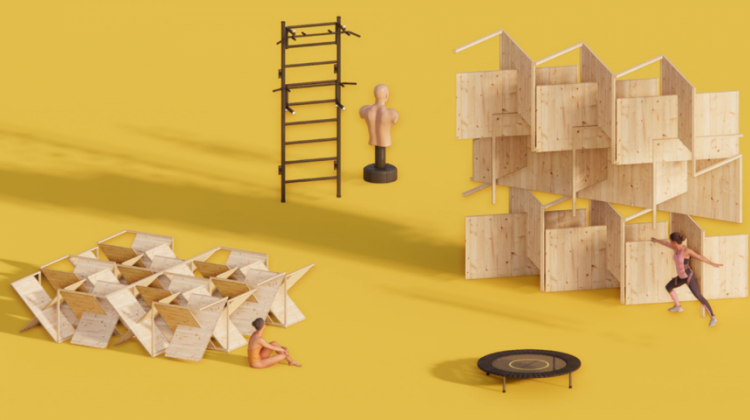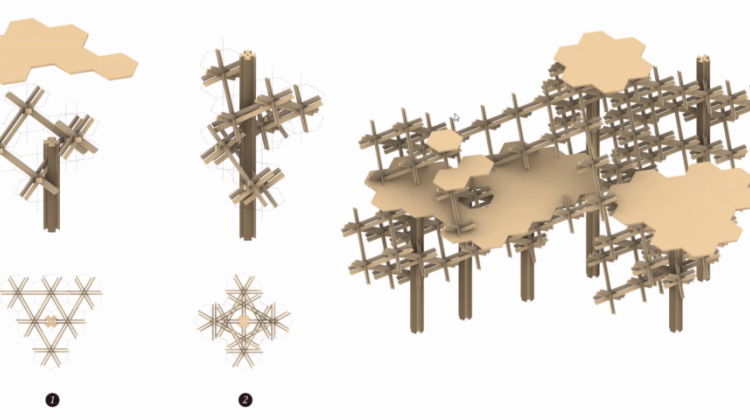Highlights from IAP 2021 Workshops


Over MIT’s Independent Activities Period (IAP), students are able to engage and experiment in workshops that differ from the typical curriculums. This year's IAP workshops reflected the design challenges and opportunities that come with remote work. Learn more about the courses that were offered this year, and the work that came out of them.
Remote Making Shop Class for Architects
Led by Zain Karsan
This workshop was designed to communicate fundamental concepts of machine building and CNC workflow to enable students to move fluidly between digital designs and physical material. Over the course of two weeks, students received kits with which to produce a desktop CNC Machine with a work area of roughly 6” x 6” x 4”. After assembling the machines, MasterCam Software tutorials enabled students to devel-op CAM files and GCode from their digital designs. Watch videos of the milling and assembly process.
Make ToGather: Interaction Design Webinar + Workshop
Led by Sheng-Hung Lee, Ziyuan Zhu, John Liu, Wei-Ching Lin, Nahun Kim, Jonathan Marcus
Sponsored by MIT Department of Architecture, MIT AgeLab, MIT Integrated Design & Management (IDM), Planet D, and Industrial Designers Society of America (IDSA)
The Interaction Design Webinar + Workshop was a part of the Make ToGather series, which aims to empower designers to apply design thinking and multidisciplinary collaboration into their everyday work and life. This event was a three-day webinar + workshop series, where professionals shared their stories and experiences in the interaction design field. The webinars were led by six creative professionals with backgrounds ranging from industrial design, interaction design, architecture, design education, innovation leadership, and entrepreneurship. To find out more, visit the Make ToGather website.
Model Cities Everywhere -- Pathways towards a Net Zero Urban Building Stock
Led by Christoph Reinhart, Samuel Letellier-Duchesne, Yu Qian Ang, Zach Berzolla
The Sustainable Design Lab offered a three-day hands-on workshop in which students were introduced to concepts and workflows of modelling operational energy use for hundreds or thousands of new or existing buildings anywhere on earth. Student groups of two were teamed up with representatives from 10 cities across the world to develop a high level carbon reduction strategy for existing buildings, build urban building energy models (UBEM) of a typical neighborhood, and quantify retrofitting costs and expected savings for the neighborhood. The resulting UBEMs can be used to develop resource-efficient new developments, to help municipalities develop greenhouse gas (GHG) emission reduction plans for their jurisdictions, to convince citizens to retrofit their homes, and to coordinate development of the building stock and the electric grid.
Zeelie Workshop with NOMAS
Led by MIT NOMAS (National Organization for Minority Architecture Students)
MIT NOMAS and Group Project hosted a day-long workshop as a part of their ongoing collaboration with Brooklyn-based artist Zeelie Brown. Zeelie used her work on “The Most Beautiful Septic Tank in the World,” (a self-assembled, compostable outhouse project in Lowndes county, Alabama) to think through plumbing, autonomy, ownership and beauty in the rural US. Workshop activities included listening, free-writing and a mini-design charette. View the pre-workshop video here, and read more about Zeelie and her outhouse project here.
out of frame Writing Workshop
Led by Ana McIntosh (M.Arch 2022, out of frame Editor 2020-21)
This workshop was a part of out of frame, a student-led online platform featuring the unseen, untold and forgotten. Past and current columnists as well as any interested students came together to cultivate writing and discussion as a way to strengthen their voices and interests while connecting with the work of their peers. Each week students participated in exercises and discussions with faculty and other guests to broaden the way they think about writing and approach their work. Throughout the course, students developed a short series of pieces aligned with their personal interests. These were workshopped though written responses and conversation with other workshop members, with students having the opportunity to read, share, and generously reflect on the work being produced.
The Untold Narratives
Led by Skylar Tibbits and Rania Kaadan (SMArchS Computation 2021)
This workshop offered students a space to use personal narratives as a design tool to voice their design intentions and interests, be it highly pragmatic or highly speculative. It is a collective for those who make in reflection - remaking a studio project away from deterministic and subjective institutional agendas while considering what design intentions to amplify, discard, or replace. Following a mindful and personal process, students were asked to revisit their studio's project brief and their own written and visual narratives to remake their design worlds through a publishable vignette. This workshop intended to develop students' design autonomy, give agency to their unfiltered design intentions, and empower their expression of design identities - to tell their "untold" narratives. Find student projects from this workshop here.
Image-Objects: Texture Mapping and Printerly Envelope
Led by Hans Tursack
Image-objects -- a term used here to denote architectural forms wrapped in photographic source material and complex graphic designs -- are frequently appearing in visual studies syllabi, experimental exhibition venues, and even as large scale built works. In this seminar, students studied historical and contemporary examples of artists and designers who employ texture mapping to generate graphic-skins for works with complex/irregular geometric scaffolds, with an emphasis on the technical processes used during the design phase and the methods offices have invented to translate their designs onto material substrates. Working individually and in pairs to generate massing schemes for large-scale architectural objects with complex graphic skins, students produced a series of three unrolled surface drawings in collaboration with Brilliant Graphics in Philadelphia, PA as archival digital prints.
Additive Timber: Generative assembly logics for circular building design
Led by Caitlin Mueller, Paul Clemens Bart, and Ramon Weber
Focusing on timber, one of the most promising building materials to reduce carbon emissions in the built environment, this one-week workshop analyzed traditional methods of construction from a tectonic, aesthetic and sustainability viewpoint to inspire new generative digital design workflows. By introducing methods for digital reassembly and the creation of novel building systems and aggregation logics that build up on traditional construction methods, students worked collaboratively to develop prototypical timber building systems that work with societies' bottom-up processes and allow for design with flexible planning parameters. The project work was accompanied by lectures and master classes from the instructors and invited experts in the fields of generative design, timber construction, and circular economy. Check out some videos and images of the final designs.
Hacking Kowloon
Led by MIT China SA+P in partnership with MIT Hong Kong Innovation Node
Even before the pandemic, digital technologies were changing patterns of social and economic life in cities. With the growth of e-commerce and other digital platforms, urban experiences are increasingly mediated through virtual platforms. While lockdowns have led to a diminishing of urban social life, this crisis also presents an opportunity to reimagine how citizens relate to each other. Can technology play a positive role in bringing citizens together and helping more urban dwellers access social and economic opportunities? MIT SA+P, in partnership with the MIT Hong Kong Innovation Node, offered a ‘virtual design course’ bringing students from Hong Kong and MIT together to address some of the challenges cities are facing now. Students participated in a January charrette, held virtually and synchronously between Hong Kong and Boston. Students were organized into groups, with each group focused on developing a masterplan for activating a particular part of Hong Kong’s Kowloon East district.
Auto-Poiesis: The Rise and Rise of Rule-Based Creative Strategies Across the Arts
Led by Mark Goulthorpe
This part-seminar, part-workshop looked to identify radical creative processes based in anomalous “machinic” generative drives. Through the avant garde period these remain quite rare, but begin to consolidate into discernible lines of inventive production. This production can be seen as a form of autopoiesis, which describes the capacity of a system to reproduce itself by creating its own parts. These novel processes, looking to exceed intuition and direct creative aptitude, seem motivated by the concussive new mnemonic apparati that were being absorbed in the avante-garde period. Students set out to "hunt the snark" in these processes, both in the sense of seeking examples that already witness autopoietic practice, but also in outlining their own precisely-indeterminate formative-isms in their own artifacts. View student work from this workshop.
Image Credits:
01 Jonathon Brearley (MArch '22), Angie Door (MArch '22), and Iris Zeng (MArch '24), final rendering. Additive Timber: Generative assembly logics for circular building design.
02 Qianqian Wan (SMArchS Urbanism '21), Patricia Dueñas Gerritsen (MArch '23), Mengqiao Zhao (MArch '22), and Ziyu Xu (MArch '21), assembly drawing. Additive Timber: Generative assembly logics for circular building design.
03 Jenna Schnitzler (MArch '24), Tiny Z milling foam. Remote Making Shop Class for Architects.
04 Sahil Mohan (MArch '24), final renderings. Auto-Poiesis: The Rise and Rise of Rule-Based Creative Strategies Across the Arts.
05 Inge Donovan (MArch '24), final collage. The Untold Narratives.
06 Jingyun Ma (MArch '24), final review pin-up. Image-Objects: Texture Mapping and Printerly Envelope.


